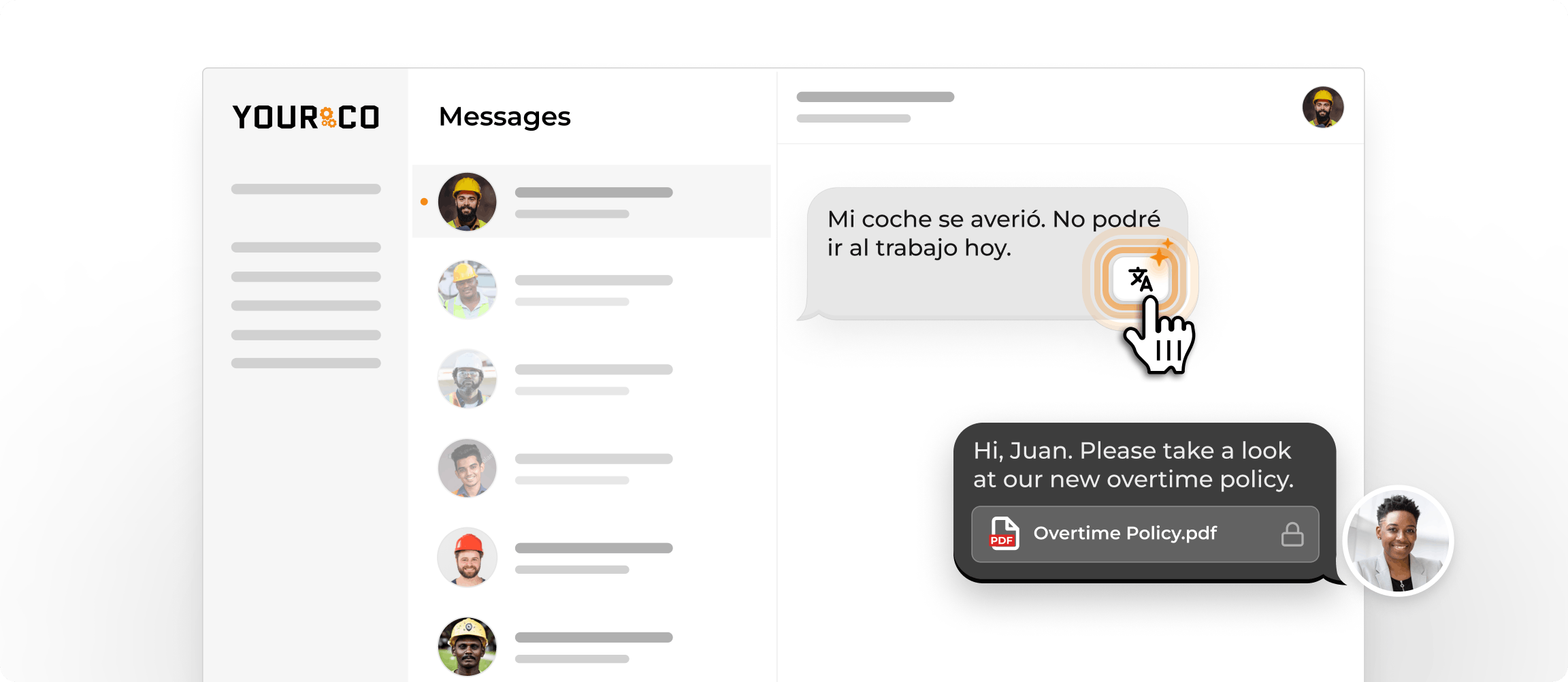Breaking Language Barriers to Foster Inclusion in Your Workforce


Language barriers represent a substantial and often overlooked obstacle. Particularly among hourly and non-desk workers, differences in language proficiency can severely impact productivity, safety, and overall team cohesion.
Employers in diverse sectors from manufacturing and logistics to hospitality and healthcare, are often confronted with the challenge of ensuring clear and effective communication across multilingual teams. Without proactive measures, these communication gaps can lead not only to operational inefficiencies but also heightened safety risks and increased employee turnover.
To create a truly inclusive workplace, organizations need to find practical solutions designed to bridge linguistic divides, combining targeted language training, technology-enhanced communication tools, and culturally aware practices.
In this article, we’ll examine the critical impacts of language barriers on workplace dynamics and explore actionable strategies that can help your organization foster inclusivity, enhance productivity, and ensure every employee feels connected and understood.
The Impact of Language Barriers
Language barriers in the workplace arise when employees don't share a common language proficiency, creating obstacles to effective communication and collaboration.
- Safety Risks: In high-stakes environments, communication failures can lead to critical errors. Studies indicate that 25% of workplace accidents are attributable to language barriers.
- Productivity Decline: Organizations face an estimated 20% decrease in productivity due to miscommunication and inefficiencies.
- Employee Isolation: Hourly workers who aren't fluent in the dominant workplace language often experience isolation and reduced participation in team activities.
- Increased Turnover: Isolation and reduced job satisfaction can lead to higher turnover rates, particularly among immigrant workers navigating cultural adjustments.
- Reduced Collaboration: Language differences can limit open idea-sharing and creative problem-solving, stifling teamwork.
- Silo Formation: In multinational corporations, language barriers can inadvertently create silos as employees cluster with colleagues who share their native tongue, undermining workplace diversity and cross-functional collaboration.
- Customer Service Impact: In customer-facing roles, language barriers can directly impact service quality and client relationships.
Strategies to Overcome Language Barriers
Implement proven strategies that center on human connection and technology to help your multilingual teams communicate effectively.
Implementing Language Training Programs
Effective language training begins with clearly understanding your team's communication needs. Start by assessing current language skills to pinpoint gaps and prioritize training on industry-specific terms and real-world workplace scenarios.
Provide a blend of structured classroom sessions and flexible online modules, accommodating various schedules and learning preferences. Classroom settings facilitate interactive practice and immediate feedback, while digital resources, such as interactive videos, quizzes, or pronunciation guides, allow employees to learn at their own pace.
Regular skill assessments help monitor employee progress, identify areas needing additional support, and keep your training relevant. Complement structured lessons with peer-learning initiatives, like language buddy systems or mentorship programs, encouraging practical skill application in everyday interactions and fostering stronger team relationships.
Using Translation Tools and Technology
To facilitate real-time communication among diverse language groups, modern translation tools are essential. These solutions streamline interactions and minimize misunderstandings, especially in industrial and field-based work environments.
- For instant messaging and email: Integrate translation plugins into your communication platforms
- For document translation: Invest in dedicated translation software that ensures accuracy, preserves context, and maintains cultural sensitivity.
When selecting workplace translation tools, consider the specific needs and communication styles of your workforce. The right technology should simplify interactions without adding unnecessary complexity. Additionally, provide training so employees can effectively utilize these tools.
Remember, translation technologies serve as valuable support mechanisms, enhancing rather than replacing human interaction and empathy. Balancing technological solutions with direct human connection ensures clear, authentic communication across your diverse team.
Establishing a Common Working Language
Introducing a common working language policy can significantly enhance clarity and unity within multilingual teams, while still respecting and acknowledging linguistic diversity. Clearly define guidelines outlining when and how the common language should be used in various workplace interactions, meetings, and documentation. Provide bilingual or multilingual resources for essential communications such as safety guidelines, onboarding materials, or company policies, to ensure full understanding by all team members.
Offer ongoing language support services, including supplementary training or language coaching, to assist employees as they develop proficiency. Ensure employees feel comfortable seeking assistance by maintaining open channels for questions and clarifications.
Remember, effective language policies prioritize practical usage and clear communication rather than insisting on flawless fluency. Continuously collect employee feedback and monitor outcomes, adjusting your approach as necessary to meet your workforce's evolving communication needs. Successfully addressing language barriers is an ongoing process requiring regular attention, flexibility, and adaptation.
Promoting Inclusive Language Practices
Language shapes your workplace culture and directly influences employee inclusion; according to McKinsey research, companies with strong racial and ethnic diversity are 35% more likely to outperform their peers financially.
Adopting Inclusive Language Guidelines
Inclusive language acknowledges diversity, conveys respect, and promotes equal opportunities for all employees.
- Use gender-neutral terms in communications
- Avoid cultural idioms or phrases that may not translate well and could alienate non-native speakers
- Write in plain language to ensure clarity for all readers
- Consider the cultural and historical context when choosing terminology
Remember that inclusive language isn’t just about being politically correct—it’s about building a workplace culture where everyone can share their insights and perspectives freely. Implementing internal communications best practices helps achieve this goal.
Providing Multilingual Resources
Support clear communication by offering multilingual resources:
- Translate essential documents and policies into the primary languages of your workforce
- Combine technology with professional translators for critical content to ensure accuracy and cultural sensitivity
- Maintain glossaries of commonly used terms
- Provide real-time translation tools for daily interactions
- Offer training materials in multiple languages and gather employee feedback to keep them fresh and relevant
According to research by Forbes, language barriers significantly impact collaboration and productivity, making professional translation services a worthwhile investment. A balanced approach of integrating cultural context and technology helps maintain effective resources that truly serve your employees and aids in communicating with non-English speakers.
Leveraging Cultural Awareness to Enhance Communication
Cultural awareness serves as a springboard for effective communication in diverse workplaces, fostering an environment that embraces collaboration, acknowledges cultural differences, and reduces misunderstandings through active engagement with various perspectives.
Conducting Cultural Sensitivity Training
Cultural sensitivity training offers teams a deeper understanding of cultural nuances. Programs might include scenario-based exercises, interactive workshops, and empathy-building activities. Research shows that effective strategies focus on:
- Realistic workplace simulations
- Highlighting how cultural differences shape communication styles
- Building empathy and adaptability
- Providing practical takeaways for day-to-day interactions
Encouraging Open Dialogue About Cultural Differences
Open conversations about cultural differences help teams build trust and address issues before they escalate. This can be achieved through:
- Regular team forums where employees share cultural perspectives
- Structured discussion groups on specific cultural topics
- Informal exchange sessions built into daily communications
- Safe spaces for questions and clarifications
Consistent practice of clear communication techniques—like using visual cues and avoiding jargon—keeps discussions productive and inclusive, especially when engaging non-desk workers.
Pairing employees from different backgrounds as mentors or buddies can create natural opportunities for personal cultural exchange.
Measuring the Effectiveness of Language and Inclusion Initiatives
You need a systematic approach to evaluate whether your language and inclusion initiatives are actually working. This requires combining both qualitative and quantitative measurement methods to get a full picture of your progress.
Start by gathering qualitative feedback through multiple channels. Conduct regular surveys to assess how employees experience language barriers in their daily work. Complement these with focus groups and one-on-one interviews to gain deeper insights into specific challenges and successes. According to research on workplace barriers, this direct feedback is crucial for understanding the real impact on employee morale and collaboration.
Track concrete metrics through Key Performance Indicators (KPIs) to quantify progress:
- Employee retention rates across language groups
- Participation levels in language training programs
- Frequency of cross-cultural team interactions
- Improvements in language proficiency assessments
- Team collaboration effectiveness scores
Monitoring these indicators can help you spot communication issues in the workplace and take proactive steps to address them.
Create a continuous improvement cycle by establishing a feedback loop. Use insights from both your qualitative and quantitative measurements to refine your initiatives. When you spot trends in the data or receive consistent feedback about specific challenges, adjust your programs accordingly.
Regular assessment of these metrics helps identify what’s working and where you need to make adjustments. Such a data-driven approach ensures your language and inclusion efforts evolve alongside your workforce’s needs while demonstrating tangible progress to stakeholders.
Embrace the Power of Inclusive Communication With Yourco

Breaking down language barriers is essential for building inclusive, cohesive, and high-performing workplaces. By adopting targeted language training programs, advanced translation technologies, inclusive communication guidelines, and culturally aware practices, you can significantly enhance productivity, safety, and employee engagement across diverse teams.
Yourco provides a comprehensive solution specifically designed to address these critical challenges. As the leading SMS-based employee platform tailored for non-desk workers, Yourco facilitates immediate, clear communication in over 135 languages. With AI-powered translations, all employees receive essential messages accurately in their preferred language, even in remote locations with limited internet connectivity. This ensures no worker feels isolated or excluded due to language limitations.
Additionally, Yourco's intuitive text-based approach eliminates common barriers associated with app downloads, password management, and complex software training. By delivering information directly via SMS, the platform significantly reduces miscommunications and the safety risks often attributed to language misunderstandings. Managers and HR teams can easily provide real-time updates, gather feedback with in-built survey and polls functionality, and swiftly address questions or concerns, enhancing operational efficiency and team cohesion.
Ultimately, adopting Yourco means committing to an inclusive communication strategy that genuinely resonates with your workforce. By making language accessibility a central component of your organizational culture, you’re empowering every employee to actively participate, remain informed, and confidently contribute to shared company goals.
Try Yourco for free today or schedule a demo and see the difference the right workplace communication solution can make in your company.



